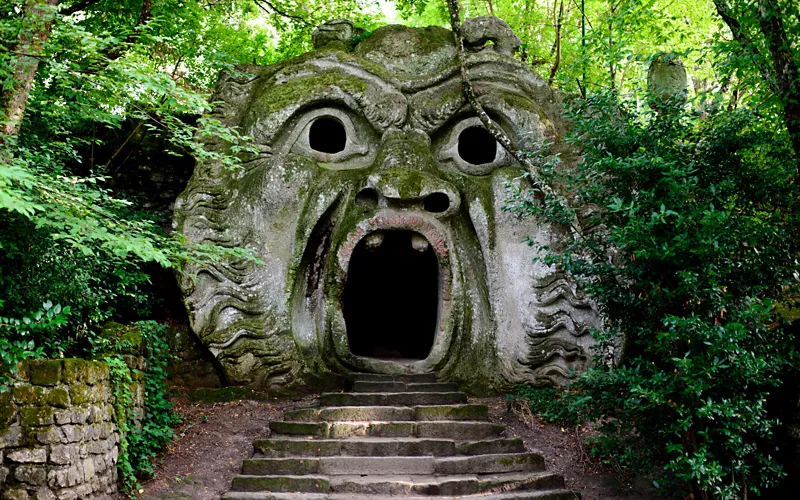This content was automatically translated. View the original text.

Overview
A mysterious fantasy world in the Sacred Grove at Bomarzo
The Bosco Sacro di Bomarzo, also referred to colloquially as the Park of the Monsters, is a garden endowed with dozens of sculptures depicting animals from a fantasy world and mythological creatures, and also small edifices immersed in the vegetation. The park was conceived in the 16th century by an eccentric prince who was assisted by Pirro Ligorio, one of the most famous architects of that period.
This curious realm of frightening creatures, which very frequently certainly reveal an enigmatic character, stimulates one’s imagination and may induce odd reactions. Much loved by children for its aura of mystery, it is the place where we can spend a few hours in the midst of a natural environment immersed in an unfamiliar world.
A unique work of the 16th century
What may be considered as the oldest sculpture park in the modern world was the result of a plan initiated by Francesco Orsini (1523-1585), the lord of Bomarzo. Perhaps by way of a tribute to his wife Giulia Farnese, who died prematurely, Orsini had a garden created which certainly presents a singular character of its own.
While in the sumptuous villas of the area the aristocratic families created elegant parks in the Italian style (a prime example of which would be the gardens of Villa Lante di Bagnaia), Orsini’s intention was to use the natural environment to create a curious venue having a decidedly enigmatic nature, and full of mystery. This represented an exceptional decision for his time.
Most of the sculptures present were produced at this site, using blocks of local peperino stone, the typical magmatic rock of the historical Tuscia region. Many researchers have dedicated great attention to this mysterious park, attempting to attain an appropriate interpretation of the objects it contains. Having recourse to literary sources, they have also hypothesised “magical-mystery” origins and the presence of an initiatory path. There is no clearly-defined answer: the Sacred Grove stimulates the imagination of each person who visits the park, generating a variety of subjective responses. The mascherone (large mask), which has become an iconic symbol of the park, bears the inscription Ogni pensiero vola, the literal sense of which is “Every thought is volatile”. This may indeed be a key concept underlying this particular divertissement of the Renaissance period.
The statues of the Sacred Grove
At the beginning of the path leading through the Sacred Grove there are the Greek sphinxes, placed next to the Orsini coat of arms. Two inscriptions pose questions to the visitor. The first seeks a response to a curious query: "You who enter here, observe each separate element, then tell me whether these marvellous works have been made to astound us or are exhibited simply for their artistic value." Individual reactions to the query tend to vary.
We then find statues of divinities such as Saturn and Janus and an anthropomorphic mask, with its wide mouth agape, surmounted by a globe. The largest statues are those of the gigantomachy, representing a conflict between two giants, Hercules and Cacus, and the turtle upon which stands Nike, the Greek goddess of victory. After the Winged Pegasus, the nymphaeum and the amphitheatre we arrive at the leaning house, a small building that evokes the sense of a ruined dwelling constructed upon a stone foundation revealing an angle of inclination of 23°, corresponding to that of the terrestrial axis. On the part of any observer the mere vision of this small tilted edifice stimulates a sensation of instability and almost a sense of dizziness, which will result in the abandonment of any certainty and definite associations. This is in sharp contrast with another nearby architectural work, presenting sober and elegant lines: a temple constructed in the classical style which is dedicated to Orsini’s deceased wife.
Our attention will now be drawn by an elephant surmounted by a small tower-like structure, a dragon, a statue of the god Neptune reposing in a wide basin, and then a space filled with stone vases with pine cones. Finally, we will find Echidna, a woman with a snake's tail instead of legs and the monstrous creature with wide open jaws. It is hard not to be impressed and internally conditioned by this array of onirical visions. The surrealist artist Salvador Dalì drew heavily on the stimuli provided by these fabulous suggestive images.
Bomarzo
The Sacred Grove is only a few minutes away from Bomarzo, the town situated on one of the last rocky spurs of the Tiber valley. In the centre of the borgo the imposing edifice that was the original place of residence of the Orsini family, now transformed into the Palazzo Comunale (municipal building), contains beautiful halls and rooms decorated with frescoes by artists who developed their skills at the school of Pietro da Cortona.
The Duomo, the principal church, embellished with a Baroque facade, is situated very close to the palazzo once inhabited by the Orsini family. The base of the bell tower rests on blocks of tufa limestone dating back to the Etruscan age, and reminds us that these sites have truly ancient origins.
A characteristic festival held in the town is the Palio di Sant'Anselmo. This horse race takes place in the Campo del Fossatello, beneath the rockface, on 25th of April and involves the participation of 5 jockeys who represent the wards of the urban centre. The traditional sweet biscotto pastry is available for everyone at the festival. Resembling a doughnut, this local speciality is made with leavened dough, with the addition of liqueurs, oil, wine and sugar, and flavoured with lemon and anise.